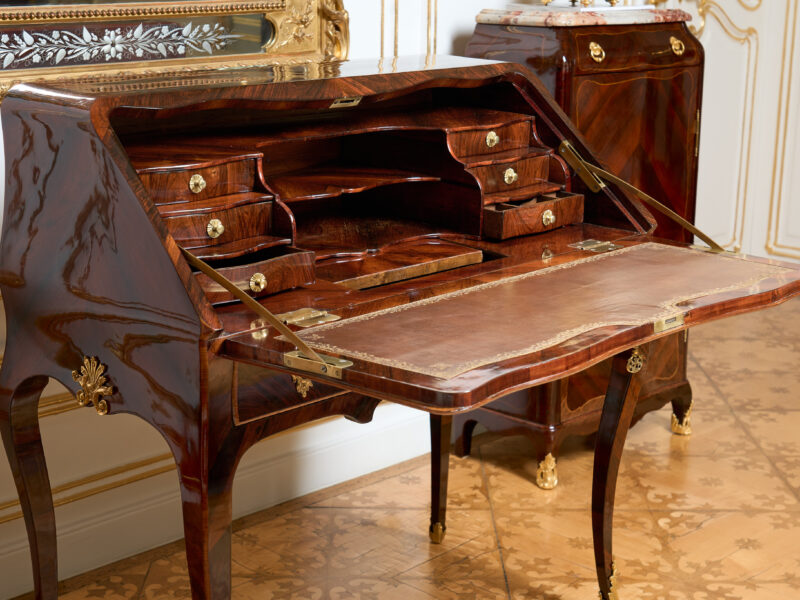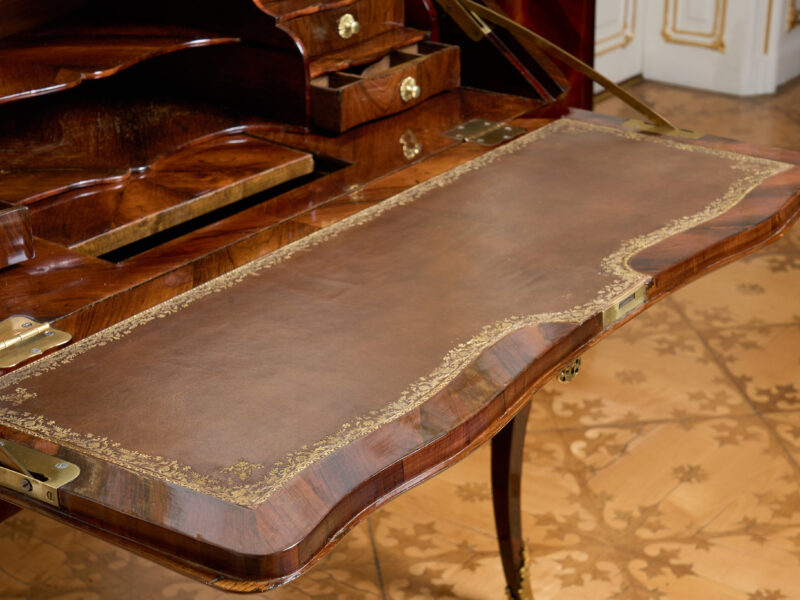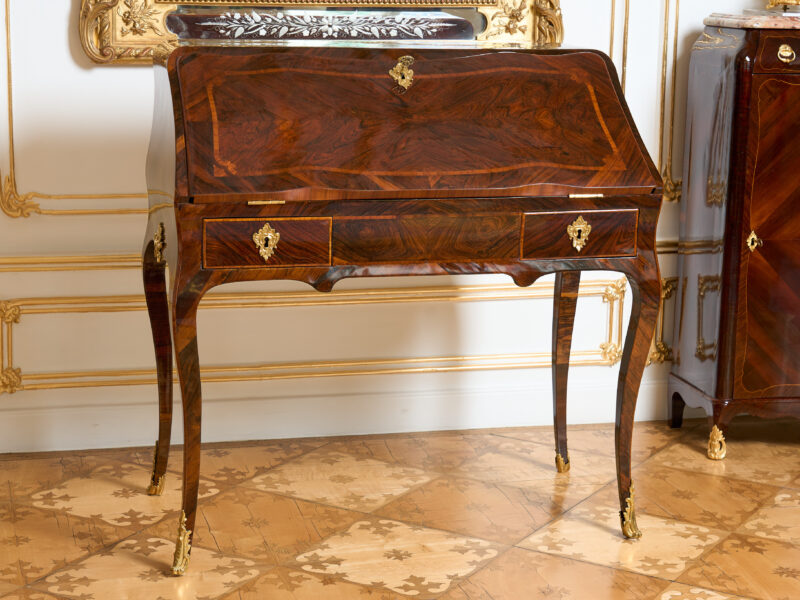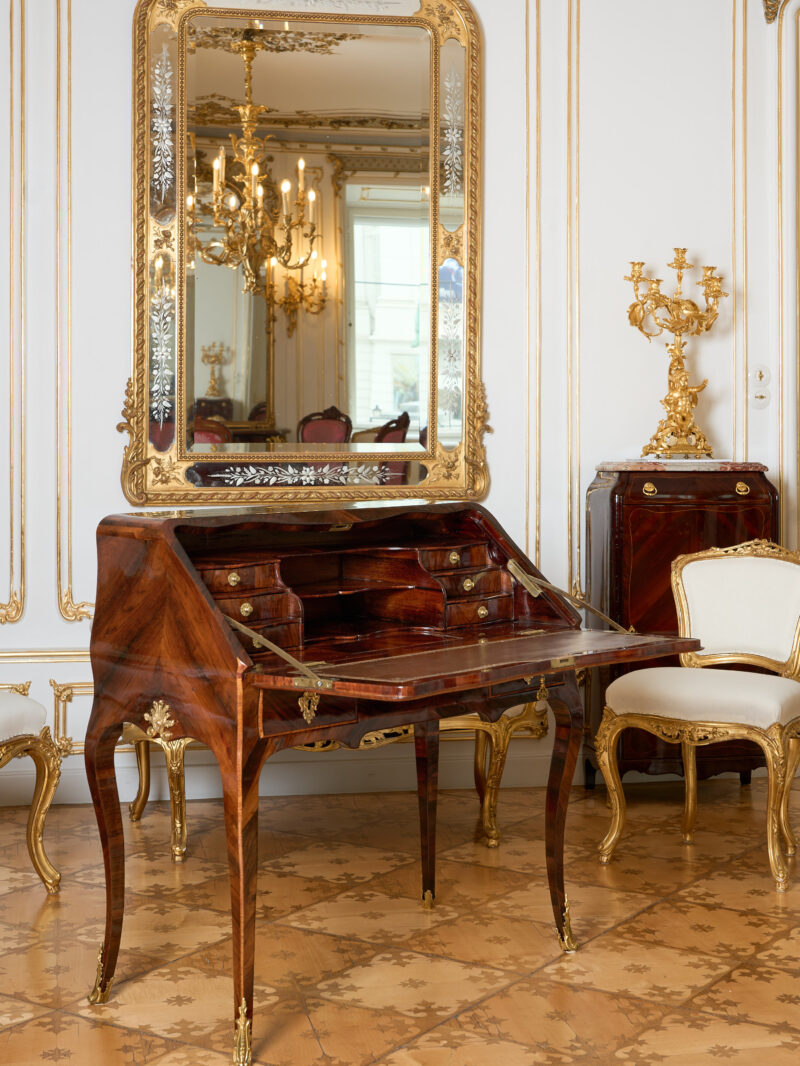
Salon Bureau Louis XV
A beautifully crafted small secretary from the renowned workshop of Pierre Migeon II.
The elegantly designed case features a fluted apron on tall, curved legs, veneered exclusively in rosewood, some of it in a so-called “Papillon” (butterfly wing) pattern.
The slanted writing surface, adorned with banded inlay, is positioned above two small drawers. Inside, the foldable writing surface is covered with gold-embossed leather. The interior of the writing furniture consists of two stacked open compartments in the center, with three stepped drawers on each side.
A secret compartment is located centrally and can be accessed by sliding a small part of the surface. Locks, legs, and side panels are adorned with fine gilt bronze elements. The small secretary was designed for use in the center of a salon, and thus, even the back is finely veneered.
An elegantly crafted small writing piece from the 18th century, made by a significant French workshop that was one of Madame de Pompadour’s favorite ateliers. Stamped under the apron “MIGEON” as well as with the Parisian guild stamp “JME”. Stamped furniture by Pierre Migeon is rare on the international art market.
Many pieces of furniture made by Migeon are today housed in major collections or museums, such as the Louvre Paris, Musée des Arts Décoratifs Paris, Petit Palais Paris, Musée Carnavalet Paris, Château de Fontainebleau, Château de Champs-sur-Marne, Musée des Arts Décoratifs Lyon, Musée de Beauvais, Residence Collection Munich, or in the Rothschild Collection, among others.
Pierre II Migeon (1701−1758) comes from a dynasty of cabinetmakers and is arguably one of the most renowned members of one of the most significant Protestant cabinetmaking families based in Paris. His father, Pierre I (ca. 1670), was a supplier to the royal court and the aristocracy. Pierre II’s career as a cabinetmaker began around 1726.
It is likely that he never officially received the title “Maître-Ébéniste,” possibly due to his strict Calvinist beliefs, which prevented him from joining the guild. It is presumed, however, that due to his exceptional talent, he was granted a special exemption. By 1739, he had taken over the management of the family workshop and the business in Rue de Carenton in the Faubourg Saint-Antoine.
Records from the company’s books in the 1730s show that Migeon ran a prosperous and successful business. Pierre Migeon II worked during this period for many prominent clients, including the Duke of Orleans, the Duchess of Bourbon, and the Duchess of Rohan, to name just a few.
From 1740 onward, he worked for the court, especially for Madame de Pompadour. He specialized in small-sized furniture, which was crafted with exquisite craftsmanship in his workshop, such as travel toilette sets, folding writing desks, and also the desk presented here.
In addition to his successful career as a cabinetmaker, he was also a highly skilled and successful merchant, sourcing materials from the most notable craftsmen of his time. Characteristic of the pieces made in Migeon’s workshops was their stylistically restrained and unembellished design. This stylistic consistency allows for a clear identification of pieces made in Migeon’s workshops.
He worked with the finest veneers of satinwood and rosewood, with embellishments in violet and amaranth wood, and is considered one of the first to use solid mahogany for his small masterpieces, often crafted for the French nobility. His son, Pierre III (1733−1775), who was made a master in 1761, was in fact more of a merchant than a cabinetmaker.
Literature:
“18th Century Cabinetmakers’, Count François de Salverte, Les Éditions d’Art et d’Histoire, 1934.
French Furniture from the 18th Century, Pierre Kjellberg, Les Éditions de l’Amateur, 2002.



